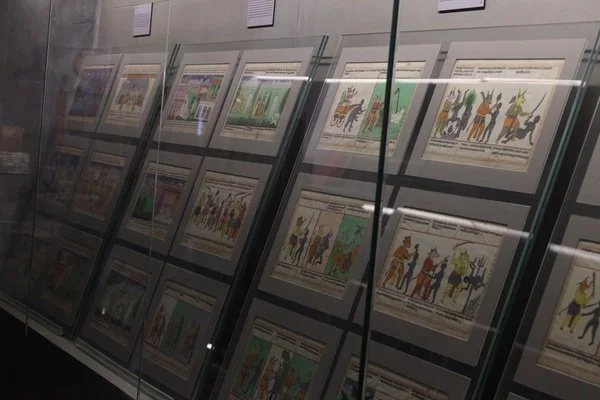Karni Bharni and Jainism: Unveiling the Unique Manuscripts at Gyan Museum
By: Nikita Sharma
Curator, Gyan Museum
At the heart of Jain philosophy lies a simple yet profound belief: every action has a consequence. This universal truth, expressed beautifully through words and images, finds one of its most striking representations in the Karni-Bharni (Action-Reaction) manuscripts. These rare treasures are preserved at Gyan Museum in Jaipur, regarded as one of the best museums in India for showcasing cultural museums in India with a rich collection of rare and unique artifacts.
These manuscripts are not merely religious texts; they are visual narratives of morality and the cosmos, created to guide individuals—especially young monks in monastic settings—on the path of righteousness. Today, they open a window into the Jain imagination of heaven, hell, and the eternal law of karma; a world where every deed shapes destiny.
What is Karni-Bharni?
The name itself says it all: Karni-Bharni means “Action and Its Result.” This series vividly portrays the law of karma, the bedrock of Jain ethics. Each folio acts like a moral mirror, reminding us that every choice we make, good or bad, sets the course for our soul’s journey.
Unlike plain textual treatises, Karni-Bharni pairs philosophy with striking visuals. Through intricate paintings, it transforms abstract spiritual concepts into powerful stories, making it not only a work of devotion but also an educational masterpiece for all levels of society.
Where Does It Come From?
The Karni-Bharni manuscripts are believed to have their roots in Gujarat, a historic center for Jain learning and manuscript preservation, known for its Gyan Bhandaras (knowledge repositories). Their inspiration can be traced back to the 11th-century Jain text Samgrahani Ratna by Śri Chandra, a key scripture of the Śvetāmbara tradition.
This intellectual tradition gave rise to many important works like:
Trailokya Dipika
Brihat Samgrahani
Laghu Samgrahani
Although the Karni-Bharni series itself is relatively recent—likely from the 19th century—it continues this rich heritage by weaving together scriptural knowledge and artistic brilliance.
The Jain Universe: A Map of Morality
Jain cosmology divides the universe into three realms:
Urdhvaloka (Upper World) – celestial heavens where gods dwell in majestic flying palaces called Vimanas.
Madhyaloka (Middle World) – the human realm, the stage for actions and karmic accumulation.
Adholoka (Lower World) – dark infernal regions where sinful souls endure punishments proportionate to their deeds.
Karni-Bharni brings these realms alive through graphic depictions of rewards and punishments. Every folio reinforces the timeless Jain truth:
“Actions bind the soul. Liberation lies in purity of conduct.”
From the golden mansions of gods to the terrifying torments of hell, the imagery nudges viewers toward a virtuous life.
Why Is It Artistically Important?
Apart from its spiritual message, Karni-Bharni is an artistic marvel rooted in the Western Indian miniature tradition. These manuscripts feature:
Bold, vibrant colors—rich reds, yellows, and deep blacks.
Expressive figures that exaggerate emotions to convey moral lessons.
Intricate details of Jain deities, celestial vehicles, and the infernal instruments of punishment.
Originally created as ritual objects, these manuscripts were often commissioned by Jain patrons as acts of piety. Their survival today at Gyan Museum speaks volumes about the community’s dedication to safeguarding its cultural heritage.
THE GYAN CONNECTIOn: A COLLECTOR’S DEVOTION
The presence of Karni-Bharni at Gyan Museum, one of the best cultural museums in India, is not accidental—it reflects the vision and devotion of Gyan Chand Dhaddha (1940–2004), the man behind the collection. A passionate art lover and connoisseur, Gyanji was deeply rooted in Jain values of ahimsa, truth, and spiritual discipline. His love for manuscripts, miniature paintings, and sacred artifacts was more than a hobby—it was a mission to preserve India’s cultural soul.
Every piece he collected tells a story of faith and refinement, and the Karni-Bharni manuscripts are a shining example of this legacy. By housing these treasures, Gyan Museum continues Gyanji’s lifelong effort to keep the wisdom of Jainism alive for generations to come.
Why See Karni-Bharni at Gyan Museum?
Visiting these manuscripts is like stepping into a world where art becomes philosophy, and philosophy becomes life. Karni-Bharni is not just a manuscript; it’s a visual sermon—bridging centuries of thought, devotion, and creativity. Standing before it, one cannot help but feel the quiet power of a tradition that has for millennia championed non-violence, truth, and liberation.
Plan your visit to Gyan Museum, one of the best things to do in Jaipur, and experience this rare dialogue between action, consequence, and the soul’s eternal quest for freedom. Don’t miss the opportunity to explore these cultural treasures that are so integral to Jainism and Indian heritage.





